Tessaiga (鉄砕牙, "Iron-Crushing Fang") is a sword wielded by the hanyō Inuyasha. It is the opposite of Sesshōmaru's inherited sword, the Tenseiga. Out of the two, Tessaiga was "the sword of destruction", while Tenseiga was "the sword of life." Tessaiga has a mind of its own, it has been seen guiding Inuyasha, such as wanting to be drawn or giving him advice; the same goes for Sesshōmaru's Tenseiga.
History
The swordsmith Tōtōsai created the Tessaiga from a fang of the daiyōkai the Inu no Taishō, the father of Inuyasha and Sesshōmaru. In its 'docile' form, the sword looked like a regular (and rather battered) katana. When wielded properly, it transformed into a weapon roughly the size of a car bumper that somewhat resembles a falchion. As Tessaiga only transformed if the user cared for humans and had yōki, this means that humans can never wield it in its true form because they do not possess yōki, it would still however protect a human wielder from deadly yōkai abilities. The Tessaiga had the power to slay 100 demons in one swing by striking the Kaze no Kizu; it also had the ability to absorb the technique or skill of a strong yōkai that was defeated with the sword.
The Inu no Taishō used the Tessaiga to steal Shishinki's Meidō Zangetsuha technique, but because of the danger the technique bore, the Tenseiga was created to contain it. When the Inu no Taishō died a barrier was put on Tessaiga to prevent full yōkai who hated humans from being able to use it, and the sword was hidden inside his grave in the world between the living and afterlife. Sesshōmaru searched for the sword some time after his father's death, but had no luck in finding it, finally he asked Inuyasha about the Tessaiga's location. After a series of events both brothers travel to their father's grave to claim the Tessaiga. Sesshōmaru was unable to touch the sword, while Inuyasha was not only able to wield it, but used it to defeat Sesshōmaru. After the battle Inuyasha became the master of Tessaiga and began to use it to aid him in battle. During a battle with the Thunder Brothers it was revealed that the sheath can 'summon' the Tessaiga. Tessaiga can also protect its master by putting a barrier around him, however the barrier the sword produces seems to only work after the attack has hit him.
Inuyasha learns how to transform Tessaiga and use its Kenatsu quickly enough. He didn't learn to use it's true power to slay 100 demons until Sesshōmaru (who had a human arm with a Shikon fragment in it so he could wield Tessaiga) briefly stole the sword and used it himself. He showed the power by summoning 100 demons and slayed them, even to the point of destroying the mountain in one slash. Even after seeing the power, Inuyasha didn't know how to use it, until he accidentally used it to prevent Miroku from being eaten by yōkai when he couldn't use his Kazaana. Naraku blackmailed Sango into stealing the sword for him by threatening Kohaku's life. After she & Inuyasha battled, it was then that Inuyasha was able to retake the Tessaiga back. Inuyasha finally discovered the secret of slaying 100 yōkai was the Kaze no Kizu and learned how to use it during another battle with Sesshōmaru. Inuyasha begun to use the Kaze no Kizu as his finishing move afterwards.
However, in a confrontation with Goshinki, an incarnation of Naraku, the Tessaiga was broken in half.[1] Tessaiga breaking reveals that it kept Inuyasha's demon blood under wraps.[2] The sword's creator, Tōtōsai, was able to repair the Tessaiga, but in doing so he used one of Inuyasha's fangs. The result is that Tessaiga now became dependent on the strength of Inuyasha himself, rather than his father's - making the weapon heavier and more difficult for Inuyasha to wield. However, at the same time Tessaiga also became much sharper and sturdier, able to match a sword forged from the tusk of Goshinki, the same Oni that originally shattered the sword. After much training, Inuyasha learned how to use a greater power based from that of the Kaze no Kizu to take out a powerful enemy, a technique known as Bakuryūha.
In the third movie of the InuYasha franchise, the combined powers of the Tessaiga and the Tenseiga succeeded in defeating the Sō'unga, the sword of world conquest, which was stronger than either of them alone.
Gaining New Powers & Abilities
As Naraku became stronger, Inuyasha began to use Tessaiga's useful power/ability-absorbing ability to strengthen the sword with new much stronger- powers and abilities to help him defeat Naraku. Seeking a way to break Naraku's Barrier, Inuyasha went to defeat the barrier-keeper of the bat demon tribe in order to obtain a technique to shatter barriers;[3] instead Inuyasha ended up helping the barrier keeper, Shiori. To thank him, Shiori allowed him to cut her orb- the source of barrier/shield-erecting power - and Tessaiga gained the power and ability to break through barriers.[4]
Subsequently, Tessaiga absorbed Hōsenki's Kongōsōha technique, but as with Red Tessaiga the power was gained by Inuyasha doing something to help others. In this case Inuyasha saved his friends from Naraku's miasma instead of trying to cut Hōsenki and strengthen the sword. Kongōsōha allowed Tessaiga to cut down Naraku's stronger barrier and cut down enemies strong enough to withstand the Wind Scar.
The next power Tessaiga absorbed was the yōki absorption from the demon sword Dakki. Unlike the previous two abilities, Inuyasha had to actually battle and destroy the sword to acquire the power. Since Dakki could absorb yōki it nearly took all of the Tessaiga's powers, but Inuyasha used his sword to destroy Dakki and gained the ability to absorb yōki in the form of Dragon-scaled Tessaiga. Inuyasha didn't master the Dragon-scaled Tessaiga right away unlike the previously acquired powers. Being a hanyō limited the amount of yōki Tessaiga could absorb before the yōki backfired on Inuyasha and injured him. By using Dragon-scaled Tessaiga to absorb the senki from a Seimiekan sent by Naraku, it purified the yōki it absorbed thereby stopping the regurgitation, but in the manga, he cut Nikosen's Life Force Stalk with the Dragon-scaled Tessaiga.
By doing this, Sesshōmaru and Tōtōsai told Inuyasha that he did not know the true meaning of Tessaiga and took a shortcut instead of mastering the form. After training, Inuyasha learned to see yōketsu of yōkai; by cutting it with Dragon-scaled Tessaiga he could destroy the source yōki thereby killing the yōkai.
The final ability Tessaiga gained was the Meidō Zangetsuha from Tenseiga. During a battle between Sesshōmaru and Inuyasha, Sesshōmaru willingly broke Tenseiga on Tessaiga to give it the Meidō Zangetsuha technique as their father had intended. The technique allowed the user to send their enemy directly to Hell. In the final battle with Naraku, Inuyasha fully mastered the technique and it changed into an attack that cut an enemy and then sent what it touched directly to Hell, and pulled the remains into the cuts.
Physical description
At first glance when not in use, the Tessaiga appeared to be nothing more than a battered katana with a heavily chipped and rusted blade with the hilt's fabric tearing away. When transformed, the blade turned into an over-sized dog's fang, fitting for its name. The cross guard turned into a large patch of fur similar to a dog's also. In the later chapters and episodes, the blade not only became slightly larger, but changed colors and transformed according to the abilities it absorbed. When Tessaiga is let go of, such as being thrown towards an enemy, it can retain its true form for a few seconds before reverting to its normal form.
Powers & Abilities
The Tessaiga can absorb the powers and abilities of any material, substance, or form of energy it comes in contact with, making itself more powerful.
Katana Form

Tessaiga's Katana Form
- Anti-Yōkai Barrier: The Inu no Taishō placed a barrier within the Tessaiga that would burn pure yōkai that attempt to touch it.[5] After the Inu no Taishō's death, Tōtōsai (being the sword's creator) is the only living yōkai that could both hold and activate the Tessaiga without harm; oddly the same would go with Shippō, who is also a pure yōkai, so it may be possible that the barrier does not affect any yōkai that shows kindness for humans or that comes with little to no malicious intent. Humans were capable of holding the Tessaiga in its untransformed katana state, with the sword's barrier protecting them from harm. Due to their hybrid nature, hanyō such as Inuyasha could both hold the Tessaiga and activate its true form if they showed compassion for humans. For unexplained reasons, when Sesshomarū grabbed Tessaiga with a human hand and on multiple occasions with his right hand, despite being rejected by the barrier, Tessaiga still transformed. Suggesting Tessaiga can be forced to transform if a strong enough yōkai were to touch it. Which would explain the need for a barrier because if Tessaiga was capable of remaining untransformed for those it seemed unworthy, there would be no need for a barrier. Although its katana form isn't very useful for attacks, it does have very strong durability, having withstood a clash with Tōkijin, which easily cut apart Hiraikōtsu, another weapon forged from a demon's body parts.
- Tessaiga's Scabbard: Being composed of the wood of Bokusenō, the Tessaiga's scabbard could deflect or resist yōki-based attacks; however, if that force was used continuously the scabbard would crack and its barrier would fail. It could also summon the Tessaiga, as seen when Inuyasha was trapped inside the flask of a sage. If the scabbard was broken, it could be repaired by leaving it beside a hive of yōkai bees, who would use their beeswax to repair it.
True Form
- Kenatsu: (剣圧, "Sword Pressure") Like many yōkai swords, Tessaiga could cut opponents without touching them by firing small concentrated bursts of yōki.
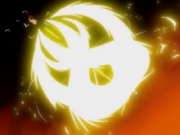
Kaze no Kizu.
- Kaze no Kizu (風の傷, "Scar of the Wind; "Wind Scar" in the English dub"): The Tessaiga's full-powered kenatsu and signature attack that could, according to legend, slay one hundred yōkai in a single strike. It was activated by sensing the fissure (or "scar") between the clashing yōki of the Tessaiga's wielder and his yōkai opponent and swinging the sword into the fissure. Inuyasha took some time to master this technique, and didn't even know of its strength at first, until Sesshōmaru showed it to him. After his battle with Ryūkotsusei, Inuyasha learned to put his own power into the attack so the scar appeared around Tessaiga's blade and could be triggered instantaneously. Until Inuyasha gained that ability, the Kaze no Kizu was not very useful against Kagura since she can change the yōki winds so they didn't clash and create the scar.
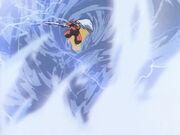
Bakuryūha
- Bakuryūha (爆流破, "Explosive-Style Destruction; "Backlash Wave" in the English dub"): The Tessaiga's ougi (lit. "ultimate technique"). It used the opponent's yōki and unleashed the Kaze no Kizu at the right point, the yōkai's energy would be reflected back with the added power of the Kaze no Kizu. Inuyasha first used the technique to defeat Ryūkotsusei by reflecting his yōki blasts back at him. However, two requirements were needed in order to implement the Bakuryūha. The first was that Inuyasha could only reflect pure energy attacks composed of yōki. The second was that his own yōki had to be at a similar level of his opponent's or the Bakuryūha would not form.
- Power Assimilation: Perhaps the Tessaiga's most useful ability is its ability to absorb the primary ability of any yōkai or yōkai-based artifact that is destroyed by its blade and convert said ability into Tessaiga's nature as a sword that cuts.
- Indestructibility: During the battle to destroy the demon sword Dakki it is revealed by Inuyasha that, though Tessaiga can be badly damaged, the blade cannot break so long as he himself is alive. Tessaiga apparently gained this ability after being reforged with Inuyasha's own fang, as the original blade had been bitten in half by Goshinki.
- Barrier of Wind: Demonstrated during the fight with Dakki, Tessaiga avoids taking direct blows when it reaches a point where it could be destroyed. It releases wind from any cracks it has, forming a protective shell around the blade.
Red Tessaiga
Red Tessaiga
- Akai Tessaiga (赤い鉄砕牙) also known as Kekkai yaburi no Akai Tessaiga (結界破りの赤い鉄砕牙, "Red Tessaiga Barrier Shattering"): This technique was obtained from Shiori's orb as a reward for saving her from her grandfather and his bat yōkai. In this state, the blade was able to cut through barriers, allowing Inuyasha to reach his enemies. Though it could cut through Naraku's Barrier at one point, it could not following the events of Mount Hakurei. It was also ineffective against holy barriers, such as Hitomiko's.
Interestingly, when Sesshōmaru fought Inuyasha when Tenseiga and Tessaiga were about to become a single sword, the Kongōsōha was ineffective against the barrier of Tessaiga's sheath (which Inuyasha used to defend himself) while the Red Tessaiga was able to destroy it.
- Enhanced Wind Scar: While in this state, Tessaiga can still produce the Wind Scar, but adds the ability to break barriers to the blast. Inuyasha had used it against Naraku and Hakudōshi, failing with both; it only worked once on its own against Naraku.
Diamond Tessaiga
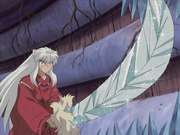
Diamond Tessaiga.
- Kongōsōha (金剛槍破, "Diamond Spear Blast; "Adamant Barrage" in the English dub"): This technique was obtained from Hōsenki after Naraku used a Shikon shard to corrupt him and forced him to fight Inuyasha. When swung, the Tessaiga fired a barrage of diamond shrapnel that could dissolve barriers the Red Tessaiga could not, including Naraku's later barriers. This technique could also be combined with the Kaze no Kizu to enhance its power. Oddly, it had no effect on the barrier of Tessaiga's sheath during the battle that joined Tessaiga and Tenseiga.
- Adamant Backlash Wave: A technique only seen in movie 4, where Inuyasha combined the Backlash Wave's power with the Adamant Barrage and Kagome's sacred arrow. The attack sends out tendrils off adamant, which pin the target in place. Inuyasha would then swing his blade, causing the adamant to shatter and fly at his enemy, releasing the demonic energy within the crystal.
Dragon-scaled Tessaiga
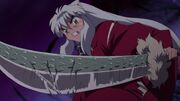
Dragon-scaled Tessaiga.
- Yōki Absorption: After breaking the yōkai sword Dakki, Tessaiga gained the ability to absorb an opponent's yōki (demonic energy) directly. Inuyasha, being a hanyō, limited the amount of yōki the sword can absorb before it backfired on the user. After being bathed in Yōreitaisei's senki, the regurgitation stopped.
- Yōketsu Cutting: After realizing the true nature of the Tessaiga was to cut, Inuyasha learned how to see yōketsu (the source of a yōkai's yōki) and used the Dragon-scaled Tessaiga to cut it, instantly destroying normal yōkai. Beings created of many different yōkai, like Naraku and Mōryōmaru, have several yōketsu, which means cutting them will destroy parts of their body and prevent regeneration of the destroyed parts; however, the Fuyōheki proved to be a nuisance as it hides yōki, preventing Inuyasha from seeing where to strike. Against stronger yōkai, the Dragon-scaled Tessaiga could cut away portions of its opponent's yōki to weaken their power, which could prove fatal.
When Inuyasha cut his own yōketsu, his full yōkai power was released and the energy flowed back into himself and Tessaiga, which caused his yōketsu grow until it devoured Sesshōmaru's completed Meidō Zangetsuha.
- Nikosen's Life-Root Stalk: Inuyasha gains the power after beating the yōkai Nikosen, who was once a hermit and imbued his holy aura in the Life-Root Stalk. After absorbing this power in to Tessaiga, Inuyasha gained the power to control the Dragon-scaled Tessaiga's demonic aura with the holy aura from the Life-Root Stalk.
Flaming Tessaiga
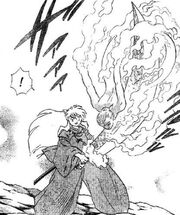
The Flaming Tessaiga
Inuyasha gains the Flaming Tessaiga after absorbing the yōkai Kinka, thus absorbing his power of flames. After using the Flaming Tessaiga in this encounter, it was never seen again.
- Flame attack - after absorbing Kinka Tessaiga absorbs his power of producing and controlling flames of fire.[6]
- Resonance - After Mōryōmaru absorbs Ginka each strike from the Flaming Tessaiga resonates with the absorbed Ginka and his lighting, causing Mōryōmaru to be attacked from the inside.[6][7]
Black Tessaiga
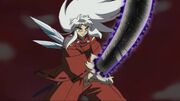
Black Tessaiga
- Meidō Zangetsuha (冥道残月破, "Dark Path of the Dawn's Moon Wave") This technique was attained when Sesshōmaru's Tenseiga broke on Tessaiga. The original technique manifested as a giant black circle that sent anything within its vicinity directly to the Netherworld. It could also be used as an escape from a Meidō one was already in, though the exit location was not set. Inuyasha also used it to reach both the closed-off path between eras in the Bone Eater's Well and the Sacred Jewel itself.
- Meidō Blades: Once Inuyasha completely mastered the Black Tessaiga, the Tessaiga could fire multiple black crescent-shaped portals that not only cut an opponent, but have their remains sucked up into the path. Thus the technique kept its original ability intact while also adding the Tessaiga's cutting nature. It seemed to be stronger than the original Meidō Zangetsuha, as it was able to tear apart Naraku's final form, which was impervious to the original move.
Trivia
- In the English adaptations of InuYasha, Tessaiga was called Tetsusaiga (or Tetsaiga) due to an error in translation in the early days of the manga when the tiny っ (tsu) kana (which indicates a glottal stop, or a doubling of the consonant that follows it) was misread as a full-sized つ (tsu) kana, altering the romanization and pronunciation of the word. Both Tetsusaiga and Tessaiga can come from the kanji; the proper spelling depends on how the name is pronounced. The proper romanization is Tessaiga. By the time Viz, the company that translates the anime and manga, realized the error, it was too late.
- Throughout the series, the Tessaiga's shape has changed between episodes. In some, it is curved near the end, and in others, it is completely straight.
- Though it was stated that the Tessaiga will repulse the touch of a demon, Shippō has been seen holding the Tessaiga once without feeling any pain. Tōtōsai was also seen holding Tessaiga, and it even transformed. Given the Tessaiga's disposition towards protecting humanity, it is likely that the barrier is not like a sacred barrier which rejects demonic auras altogether, but rather the ill-will most demons feel towards humans. As Shippō is young, he does not bear ill-will towards humans and therefore, unlike Sesshōmaru or Jaken, is not rejected by Tessaiga. Because in Tōtōsai's case, the sword not only accepts his touch but also transforms, it is most likely the case that, as he was the original forger of the sword, he has a special connection to it and is able to use it in ways normal demons could not, circumventing its normal restrictions.
- On another note, in Swords of an Honorable Ruler, Sesshōmaru briefly wielded the Tessaiga and it even transformed, but his hand was badly burned, when Inuyasha was possessed by the Sō'unga. Sesshōmaru also wielded Tessaiga in episode 134 to free Lady Sara from the demons that possessed her, and once again his palm suffered burns.
This shows that the barrier on Tessaiga can be forcibly by-passed and used by a full demon if they are strong enough to do so and endure the ensuing pain.
- The Tessera possesses similar characteristics to the sword used by Kinnii from Ranma ½.
- The Tessaiga is available as a long sword weapon in the Monster Hunter 3 Tri, however it is exclusive to Japan.
- Also available in Monster Hunter Portable 3rd only after clearing a download quest and obtaining tickets to create it.
- Tessaiga, along with Inuyasha, Shippō, Miroku, and Kagome make a cameo appearance in Ranma 1/2 OVA Episode 13. During one of Akane's nightmares, Tessaiga is seen in its true form, stuck in the floor. Tessaiga is seen behind Inuyasha's and Shippō's dead bodies located on Akane's left.
- Several of the Tessaiga's named techniques have a "crush" theme naming (with the kanji "破", meaning crush, rip, tear, or (more so) blast), nodding to Tessaiga's translation as the "Iron-Smashing Fang." (The "sai" and "ha" are two different kanji however.) The only exception is the Meidō Zangetsuha, which uses the kanji for "wave" instead of "crush."
- In Episode 130: Shippō's New Technique, The Heart Scar!, a comedic filler episode, Inuyasha humorously told Shippō the real secret to using Tessaiga to its fullest was by making the right onomatopoeia noises when swinging it. Also it would seem he was the only demon to handle Tessaiga without being repelled by it.
- Technically and chronologically, Meidō Zangetsuha was the first power Tessaiga ever absorbed.
- In 2015, an attempt to forge a replica of the Tessaiga was made by blacksmiths on the YouTube series Man At Arms: Reforged. However, the resulting sword differed from the actual Tessaiga in several respects: the sword was shorter, narrower, and thinner than the actual Tessaiga, and, most notably, the blacksmiths added an original, ornamental design onto the blade itself that was intended to mimic the appearance of the Tessaiga's transformation during the Meido Zangetsuha technique (i.e. the "Black Tessaiga"), a stylized representation which obviously is not present on the physical blade of the Tessaiga in the series.[8]
- Although the matter was raised by Inuyasha, as concern for Sesshōmaru, after he gained Meidō Zangetsuha, it wasn't explained nor went into detail if Tessaiga absorbed all of Tenseiga's healing powers as well. Though it is unlikely, as Tenseiga would then otherwise be useless until Tōtōsai gave the power back to Tenseiga.
References
- ↑ InuYasha anime; Episode 43
- ↑ InuYasha anime; Episode 44
- ↑ InuYasha anime; Episode 73
- ↑ InuYasha anime; Episode 74
- ↑ InuYasha anime; Episode 79
- ↑ 6.0 6.1 InuYasha manga; Chapter 421
- ↑ InuYasha manga; Chapter 422
- ↑ AWE me (January 12, 2015). "Inuyasha's Tessaiga (InuYasha) - MAN AT ARMS: REFORGED". YouTube. Retrieved January 13, 2015.
